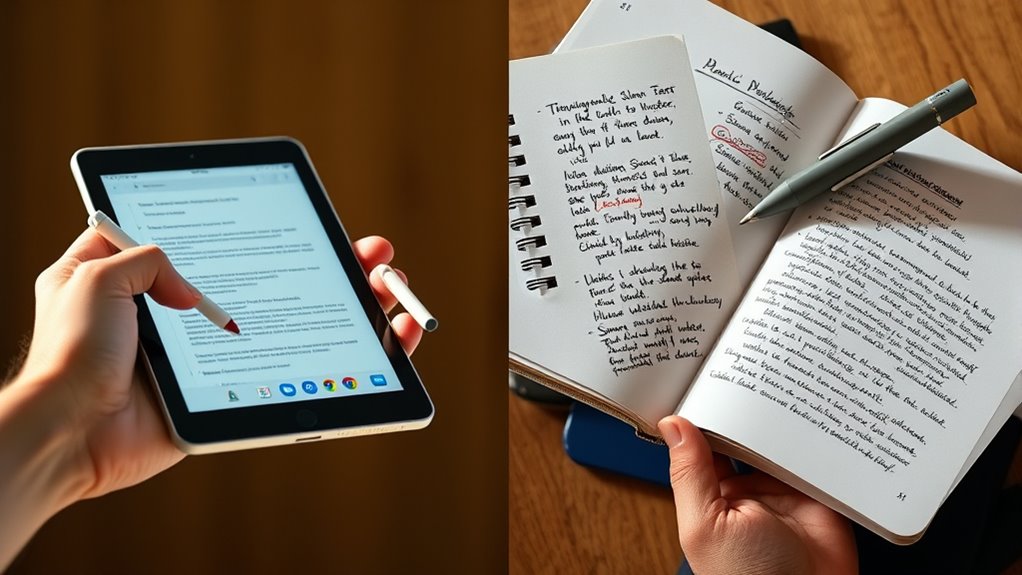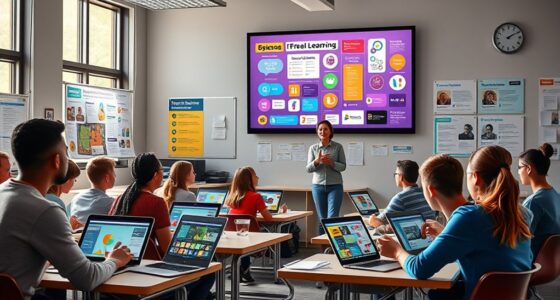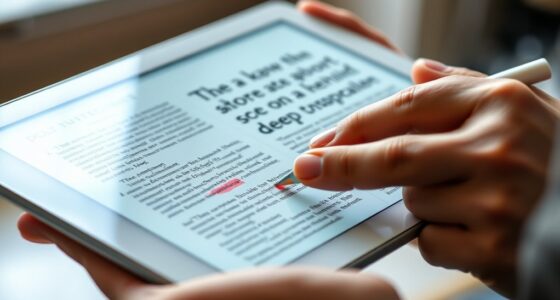Choosing between digital and paper note-taking depends on your learning style. Digital methods let you quickly capture, organize, and search your notes using devices like tablets and laptops, making review easy. Handwriting slows you down, encouraging active engagement and better memory retention. Combining both approaches can help you maximize benefits—using digital tools for review and paper for in-the-moment understanding. Continue exploring to discover which method suits you best.
Key Takeaways
- Digital note-taking offers quick access, easy organization, and multimedia integration, ideal for review and sharing.
- Handwriting promotes active engagement, deeper processing, and better memory retention, especially during lectures.
- Digital methods can be distracting and may lead to superficial understanding if not managed properly.
- Handwriting can be slower and less efficient for large or fast-paced note-taking but enhances comprehension.
- Combining both approaches leverages their strengths, catering to diverse learning styles and maximizing retention.

Have you ever wondered why some students seem to grasp material faster and retain information longer? The secret often lies in their note-taking methods. Whether you prefer digital tools or traditional paper, understanding how each approach impacts your learning can help you choose the best strategy. Digital tools, like tablets and laptops, offer convenience and quick access to a variety of features. You can type notes rapidly, search for keywords instantly, and organize your material with folders or tags. These advantages make it easier to review and revise your notes, especially when you’re pressed for time. However, typing can sometimes lead to more superficial processing. When you type, you might focus on capturing every word rather than understanding concepts, which can hinder retention.
On the other hand, handwriting techniques involve taking notes with pen and paper. This method might seem old-fashioned, but many students find it more effective for learning. Writing by hand slows you down, forcing you to summarize, paraphrase, and synthesize information as you go. This active engagement with the material helps reinforce understanding and improves memory. Additionally, handwriting creates a physical connection to the content, making it easier to recall later. The tactile nature of writing often results in better retention because it demands more cognitive effort compared to typing. Plus, the act of handwriting can reduce distractions from notifications or multitasking, allowing you to focus fully on the material. Using varied note-taking methods can further enhance learning outcomes by engaging different cognitive processes.
Both methods have their strengths, but it’s essential to contemplate your learning style. If you’re a visual learner, digital tools may offer features like highlighting or inserting diagrams that enhance comprehension. If you learn best through kinesthetic activities, handwriting techniques provide that hands-on experience that boosts memory. Some students even combine both approaches: using digital tools for reviewing and organizing notes, while relying on handwriting during lectures to process information more deeply.
Ultimately, the choice depends on your personal preferences and goals. Try experimenting with both methods to see which one helps you retain information longer and makes studying more effective. Remember, the key isn’t just in how you take notes, but also in how actively you engage with the material afterward. Whether digital or paper, the most successful note-takers are those who tailor their approach to maximize understanding and retention.
Frequently Asked Questions
Which Note-Taking Method Improves Long-Term Retention Best?
You want to know which note-taking method boosts long-term retention most. Generally, methods that enhance memory retention involve active engagement and processing information deeply. When you use paper, it often encourages better cognitive engagement because writing by hand helps encode information more effectively. Digital tools can also support retention through features like highlighting and organization. Ultimately, choosing a method that keeps you actively involved improves your long-term memory retention.
How Do Note-Taking Strategies Differ for Visual Versus Auditory Learners?
You should tailor your note-taking strategies to your learning style. Visual learners benefit from diagrams, charts, and color-coding to enhance visual memory. Auditory learners find it helpful to incorporate recordings or read notes aloud for auditory reinforcement. Adapting your methods this way makes it easier to retain information and strengthens your understanding, aligning your techniques with how you best process and recall new material.
Are There Specific Note-Taking Apps Recommended for College Students?
You might wonder which note-taking apps suit college students best. Look for apps that offer app customization, so you can tailor features to your needs. While handwriting benefits are notable with paper, some digital apps now mimic handwriting and allow easy organization. Try apps like Notability or OneNote, which offer customization options and support handwriting, combining the benefits of traditional and digital methods for effective note-taking.
How Can Students Adapt Note-Taking Methods for Remote or Online Classes?
Did you know that over 60% of students find digital organization essential for remote learning? To adapt your note-taking for online classes, you should use apps that support digital organization and online collaboration. This way, you can easily access, share, and edit notes in real-time, making your study sessions more efficient. Embracing digital tools helps you stay organized and connected, even when learning remotely.
What Are the Environmental Impacts of Digital Versus Paper Note-Taking?
When comparing digital and paper note-taking, consider their environmental impacts. Digital note-taking reduces paper use, helping you recycle paper and cut down on deforestation. However, it creates digital waste, which can harm the environment if not properly managed. Paper notes, while biodegradable, contribute to deforestation and waste if not recycled. Your choice affects the environment—opting for digital can minimize paper waste, but you should also manage digital waste responsibly.
Conclusion
Ultimately, your note-taking method is the compass guiding your learning journey. Whether you choose digital or paper, think of each as a lighthouse illuminating different paths through the fog of information. Embrace the one that resonates with your style, knowing it’s a tool that shapes your understanding. Like a lighthouse’s beam, your notes can lead you to clarity and insight, illuminating your path toward success in every academic voyage.









